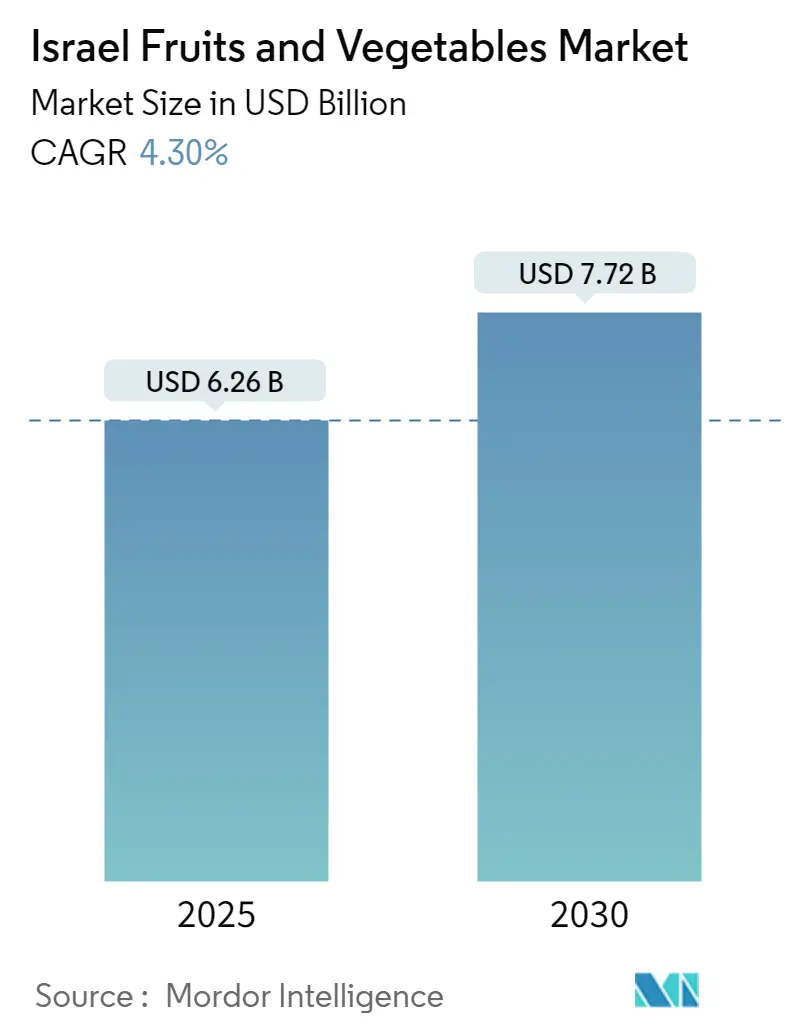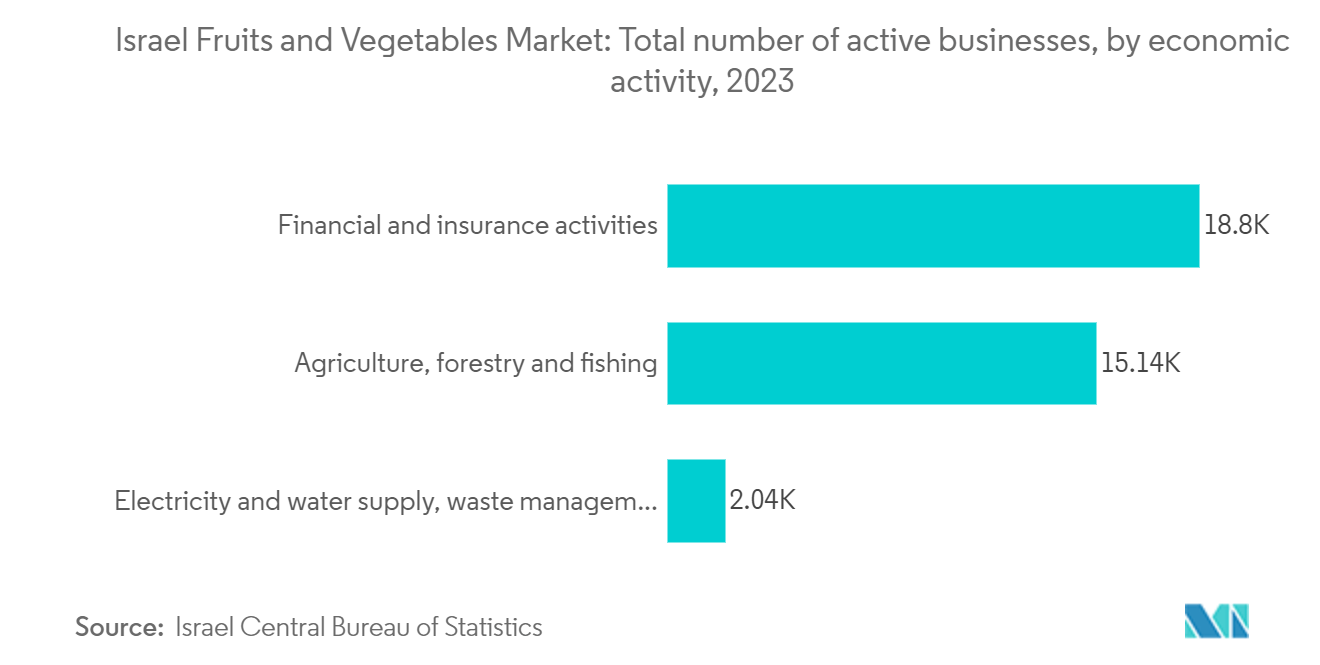
Israel Fruits & Vegetables Market Analysis by Mordor Intelligence
The Israel Fruits & Vegetables Market size is estimated at USD 6.26 billion in 2025, and is expected to reach USD 7.72 billion by 2030, at a CAGR of 4.3% during the forecast period (2025-2030).
Israel's fruit and vegetable market, known for its technological advancements and efficiency, significantly shapes the nation's agricultural sector, even amidst challenges like water scarcity and climatic constraints. Urbanization and rising disposable incomes have spurred a growing demand for fruits and vegetables, as healthier dietary choices gain prominence. The Israeli diet boasts a variety of fruits and vegetables, from citrus fruits, mangoes, and avocados to grapes, pomegranates, tomatoes, and carrots. Leading the charge in agricultural innovations, Israel employs advanced irrigation methods, greenhouse cultivation, and growth house techniques. Highlighting this trend, Northern Israeli startup MetoMotion unveiled its Greenhouse Robotic Worker (GRoW) in August 2022. This groundbreaking technology, designed for tomato harvesting in greenhouses, boasts AI-driven 3D stereo vision for fruit identification, a specialized tool for damage-free harvesting, and advanced analytical software. Such innovations not only tackle labor shortages in agriculture but also promote sustainable farming, driving market growth. Furthermore, Israel is a key exporter of fruits and vegetables, targeting European nations and the US Data from the ITC Trade Map reveals that in 2023, potatoes topped the export list, with 155,496 metric tons fetching a value of USD 88.56 million. To bolster innovation and self-reliance in the industry, the Israeli government extends financial support to the fruits and vegetables sector through various means. A notable instance is the USD 50 million loan allocation in 2022, aimed at assisting farmers of export-centric crops like avocados, almonds, and citrus fruits during economically challenging times.
Israel Fruits & Vegetables Market Trends and Insights
Technological Advancements in Farming
Israel, often called the "Startup Nation," has made remarkable advancements in agricultural technology, particularly in cultivating fruits and vegetables in the arid Negev desert. Renowned for its leadership in precision farming, Israel employs advanced computer systems to manage climate-controlled plastic greenhouses, focusing on high-value crops. However, despite being a significant producer of fruits and vegetables, Israeli farmers grapple with post-harvest losses, affecting their market value. To combat these losses, concerted efforts are underway at the farm level. A notable example is from August 2024, when Israeli startup Natural Offset Farming (NOF) unveiled "NOFcooling," an innovative cooling device harnessing liquid carbon dioxide for energy-efficient produce cooling in precision agriculture. This equipment can handle 500 kg, 200 kg, or 100 kg batches of fruits and vegetables. Given these advancements, Israel's cutting-edge agricultural technologies are set to boost fruit and vegetable yields, bolster food security, and enhance precision agriculture, all fueling market growth in the foreseeable future.

Fruits Are Highly Preferred In Israel
Israel is globally recognized for its advanced technology in agriculture, allowing the country to overcome challenges posed by climate and water scarcity, consequently boosting fruit production capacity. The country produces fruits, such as citrus fruits, bananas, pomegranates, avocados, loquat, and dates. According to the Food and Agricultural Organization, Israel's fruit production was 14.5 million metric tons in 2019, which increased to 16.3 million metric tons by 2022. Fruit production is dispersed throughout the country, ranging from the southern Eilot region to the northern Mount Hermon and from the Jordan River in the east to the Mediterranean Sea in the west. Additionally, citrus fruits and avocados make up a substantial portion of Israel’s fruit production, accounting for about half of the total output. According to data from the United States Department of Agriculture in 2022, citrus fruits and avocados collectively represent 44.8% of overall fruit production in Israel.
Fruit consumption in Israel is closely associated with various health benefits, primarily attributed to the country's embrace of the Mediterranean diet. The Mediterranean diet, which is widely prevalent in Israel, consists of a variety of fruits. Research from various cohort and case studies indicates that a higher intake of the Mediterranean diet is linked to a decreased risk of developing various types of cancer, including digestive and breast cancer. The growing health consciousness among Israeli consumers, particularly the millennial demographic, has been fueling the consumption of fresh produce, particularly fruits.

Israel Fruits & Vegetables Market Report Scope
Fruits and vegetables are important supplements to the human diet as they provide the essential nutrients for maintaining health.
The Israel fruits and vegetable market is segmented into fruits and vegetables. The report offers an analysis of production (volume), consumption (value and volume), import (value and volume), export (value and volume), and prices. The report offers the market size and forecast in both value (USD) and volume (metric tons).
| Production (Volume) |
| Consumption (Value and Volume) |
| Import (Value and Volume) |
| Export (Value and Volume) |
| Production (Volume) |
| Consumption (Value and Volume) |
| Import (Value and Volume) |
| Export (Value and Volume) |
| Vegetables | Production (Volume) |
| Consumption (Value and Volume) | |
| Import (Value and Volume) | |
| Export (Value and Volume) | |
| Fruits | Production (Volume) |
| Consumption (Value and Volume) | |
| Import (Value and Volume) | |
| Export (Value and Volume) |
Key Questions Answered in the Report
How big is the Israel Fruits & Vegetables Market?
The Israel Fruits & Vegetables Market size is expected to reach USD 6.26 billion in 2025 and grow at a CAGR of 4.30% to reach USD 7.72 billion by 2030.
What is the current Israel Fruits & Vegetables Market size?
In 2025, the Israel Fruits & Vegetables Market size is expected to reach USD 6.26 billion.
What years does this Israel Fruits & Vegetables Market cover, and what was the market size in 2024?
In 2024, the Israel Fruits & Vegetables Market size was estimated at USD 5.99 billion. The report covers the Israel Fruits & Vegetables Market historical market size for years: 2019, 2020, 2021, 2022, 2023 and 2024. The report also forecasts the Israel Fruits & Vegetables Market size for years: 2025, 2026, 2027, 2028, 2029 and 2030.
Page last updated on:
Israel Fruits & Vegetables Market Report
Statistics for the 2025 Israel Fruits & Vegetables market share, size and revenue growth rate, created by Mordor Intelligence™ Industry Reports. Israel Fruits & Vegetables analysis includes a market forecast outlook for 2025 to 2030 and historical overview. Get a sample of this industry analysis as a free report PDF download.


